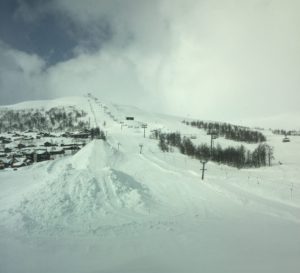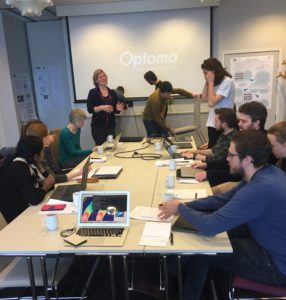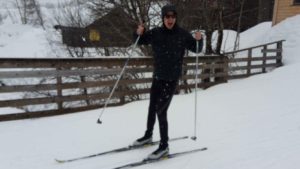by Ben Kiesling
From March 13th thru 17th, #ice2ice researchers from Copenhagen and Bergen and a handful of guests from around the world convened in Myrkdalen, Norway, to discuss what the project has achieved to date and how to move forward. As an American PhD student visiting the University of Copenhagen, I was lucky enough to join the Annual Meeting and get a first-hand look at the groundbreaking science the Ice2Ice team is doing.

My first experience with Ice2Ice was in January 2017, when I joined a group of 15 other students at a the week-long ice2ice PhD Bootcamp. I spent that week together with four other PhD students working on ice velocity data from the floating ice tongue of 79ºN Glacier in Northeast Greenland. During the week in January, we were able to accomplish quite a lot, most importantly developing a flexible method for determining the stresses and strains in the floating ice tongue using different datasets. The Annual Meeting in Myrkdalen gave us a chance to get feedback from our mentors and peers and discuss a realistic timeline for moving forward with the project, both of which are invaluable as we work towards publishing our results.

Although I came to the Ice2Ice meeting to help present my work from the ice2ice PhD bootcamp, I ended up getting much more out of it than I anticipated. Highlights were hearing about ongoing work to understand how the mass balance of the Greenland ice sheet has changed over the last 10,000 years, and to what extent these changes are linked to variations in sea ice. During plenary sessions at the Annual Meeting we discussed how the project has already begun to characterize how changes to the ice sheet and the sea ice affect atmospheric circulation and global climate. Continuing to study these processes is critical for improving our ability to forecast future climate change as Arctic ice cover, on land and in the ocean, continues to shrink. But for me, the most exciting discussions were “off-the-record.” Coffee breaks and afternoon pauses were a great time to catch up with Ice2Ice glaciologists and discuss wild ideas about the past history and future changes to the Greenland ice sheet. I don’t want to spoil anything, but I will say, I look forward to collaborating with scientists from Bergen and Copenhagen long after my visit to Europe ends.
A lot of time was spent talking science at the Annual Meeting, with discussions often spilling over into our shared mealtimes. But it would be a shame (and utterly non-Norwegian!) to travel to such a beautiful place and spend the entire week in a conference room. Our brains brimming with thoughts of Greenland and Dansgaard–Oeschger Events, many of us spent part of the afternoon hitting the slopes. Threatening low clouds and periodic rain would normally have kept me from skiing, but in my experience, it’s hard to spend any time in Norway without really wanting to be outside. And besides, as some of my colleagues liked to remind me, there’s no such thing as bad weather, you just need the right clothes!
